The orca whale, also known as the killer whale, is a remarkable marine creature with considerable power and beauty. As the largest member of the Delphinidae family, the orca is renowned for its intelligence, complex social structure, and impressive hunting abilities. Though the orca whale is a dolphin, all dolphins are considered whales, scientifically speaking. In this article, we will highlight how fast orcas can swim and provide a brief overview of these magnificent creatures to understand their fast swimming abilities.
Let us delve in!
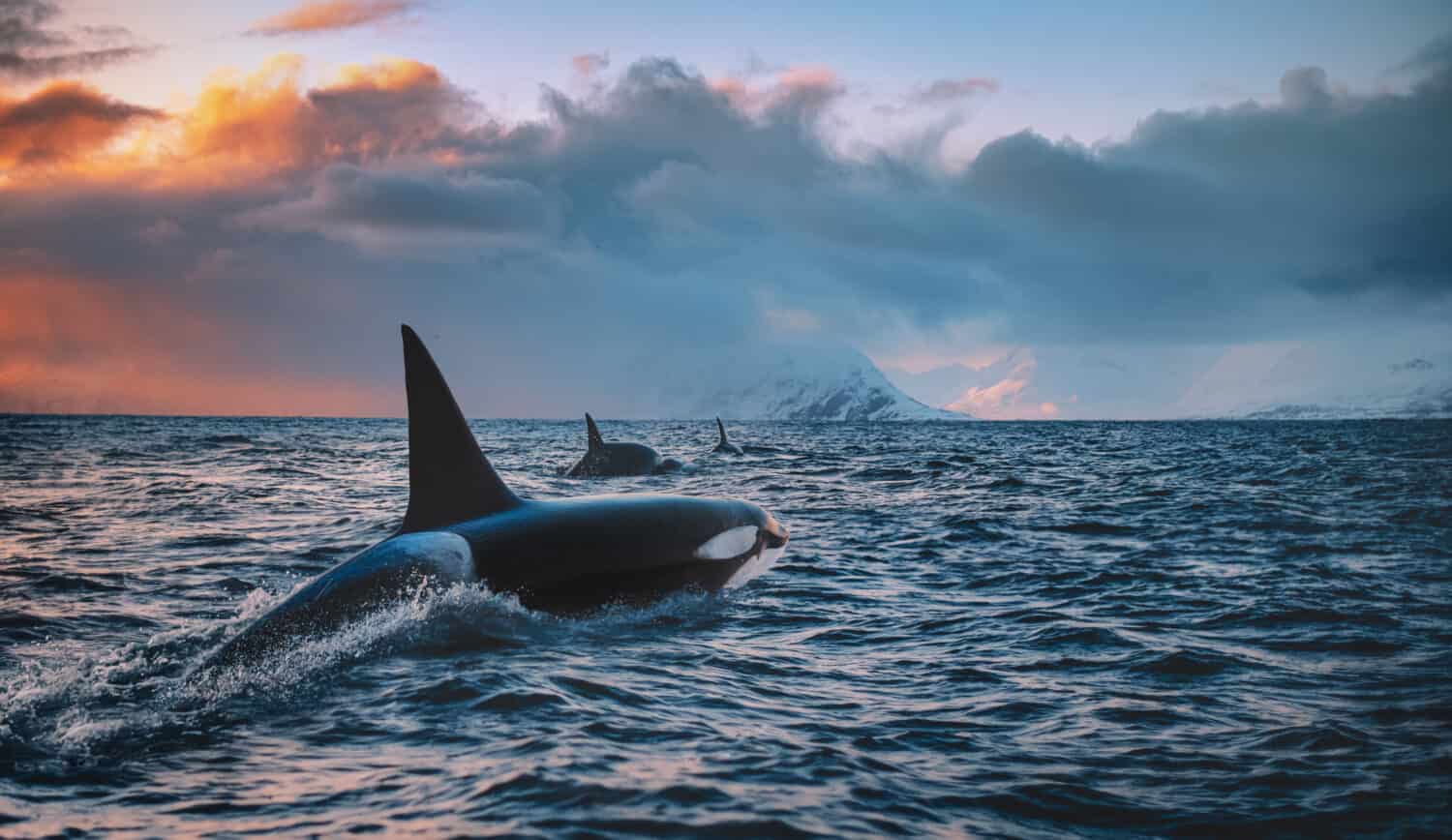
Orcas are powerful apex predators of the sea.
©Willyam Bradberry/Shutterstock.com
How Fast Can Orcas Swim?
Orca whales are awe-inspiring creatures that are divided into three ecotypes. Each type possesses incredible swimming abilities that may differ slightly from each other or specific population. Overall, these marine giants are renowned for their speed and agility in the water. They are among the fastest marine mammals, capable of reaching impressive speeds as they glide through the ocean depths.
The orca’s physical strength is intense. These marine mammals possess exceptionally powerful tail flukes that propel them through the water. At cruising speed, orca whales swim approximately 3 to 4 knots (3.5 to 4.6 mph). This steady pace allows them to cover moderate distances while navigating their marine habitats. At cruising speed, orcas demonstrate their agility and efficiency in propelling themselves through the water.
Orca whales can exhibit astonishing bursts of speed. An example would be during hunting pursuits when they can reach remarkable velocities that leave their prey with little chance of escape. With their exceptional swimming ability, orcas can achieve top speeds of roughly 30.4 knots (35 mph). However, they are capable of slightly faster bursts of speed during times of particularly intense activity.
Hunting Prey
The high swimming speed of orcas enables them to launch powerful attacks on their prey. When hunting marine mammals like seals, sea lions, or even other whales, orcas employ strategic tactics and utilize their agility to their advantage. They often create large waves and employ synchronized movements to disorient and separate their prey from their group. Once isolated, they can unleash rapid and forceful bursts, using their powerful tails to deliver swift and incapacitating blows. The impact from their fast and forceful strikes can cause significant damage to their prey, stunning or even killing them.
Porpoising
Orcas also employ a technique called “porpoising,” which involves powerful speed. This technique involves leaping out of the water, exposing their body before diving back in. Porpoising allows them to reduce water resistance and increase their velocity, reaching even higher speeds. This behavior occurs during periods of high activity or when they are engaged in energetic pursuits, such as hunting or social interactions.
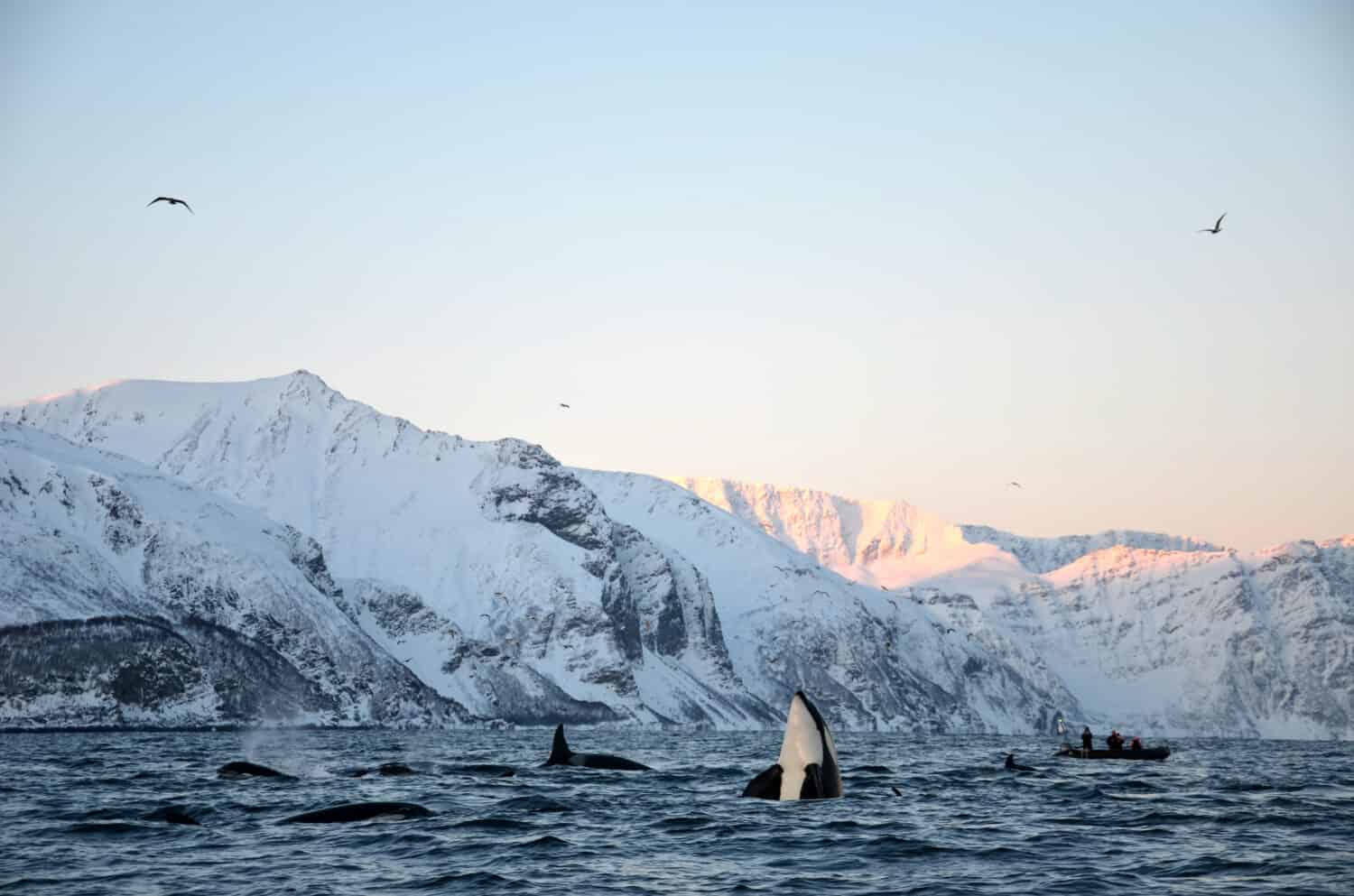
Orcas utilize a technique called “porpoising.” This involves fast speeds to break the surface of the water.
©theycallmethewildrose/Shutterstock.com
Techniques Used to Measure Orca Speeds
Researchers and scientists utilize various techniques and technologies to measure orca whale swimming speeds. One standard method involves attaching digital tags to the whales. These tags are equipped with sensors and recorders that gather data on the orcas’ movements, including speed and acceleration. By analyzing the information collected from these tags, researchers can determine the swimming speeds of orcas during different activities and behaviors. The University of British Columbia has conducted thorough research studies involving this technique.
Additionally, researchers may use hydrophones and underwater microphones to detect and record the vocalizations produced by orcas during their swimming activities. By analyzing the frequency and pattern of these vocalizations, scientists can gain insights into the speed and intensity of the orcas’ movements.
Orca Swimming Speeds Vary
It is important to note that the swimming speed of orcas can vary depending on various factors, including their age, health, ecotype, and the specific circumstances in which they are swimming. Factors such as water temperature, prey availability, and social interactions can also influence their swimming speeds. Additionally, different populations of orcas may exhibit variations in their swimming abilities and speeds based on their unique environmental conditions and hunting strategies.
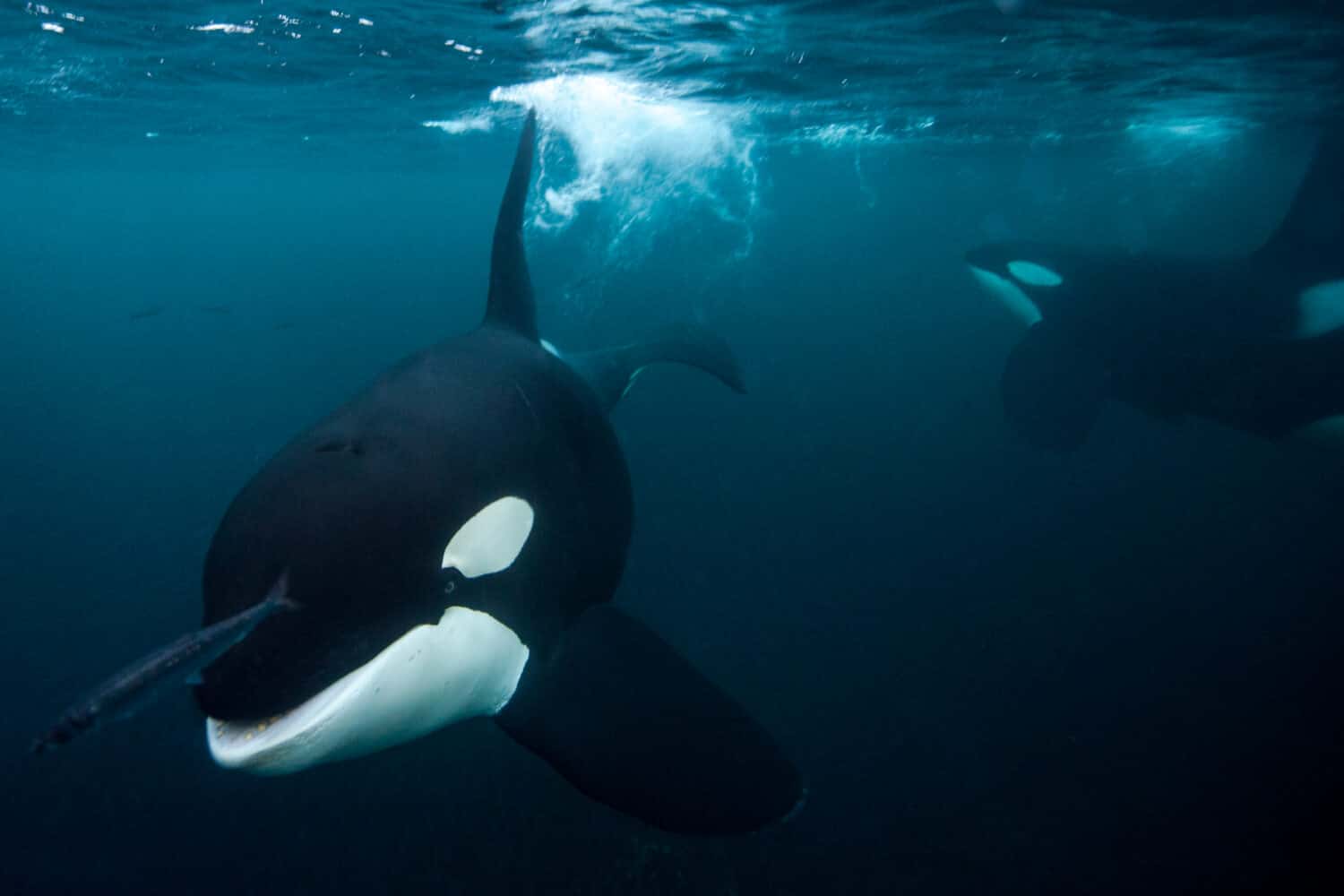
Orcas can reach speeds upwards of 35 mph during periods of intense activity.
©Petr Slezak/Shutterstock.com
There are Three Ecotypes of Orcas
These majestic marine mammals exhibit an incredible range of characteristics and behaviors, leading to questions about the existence of different species or subspecies within Orcinus orca.
While orcas are commonly referred to as a single species, Orcinus orca, recent research and scientific studies suggest that there may be different ecotypes or populations (subspecies) within this overarching classification. These various ecotypes of orcas have distinct characteristics, including variations in appearance, diet, behavior, and vocalizations.
Currently, three main types or ecotypes of orcas are recognized based on their geographical distribution, dietary preferences, and genetic differences. These are known as the resident, transient, and offshore ecotypes.
Resident Orcas
Resident orcas are primarily found in coastal regions and exhibit a preference for fish as their primary food source. They tend to stay within specific areas, forming stable social groups known as pods. These pods consist of related individuals and consist of strong social bonds. Resident orcas also have subtypes based on their specific geographic locations. Notable examples include the Southern Resident orcas in the northeastern Pacific Ocean and the Northern Resident orcas in the coastal waters of British Columbia.
Transient Orcas
Transient orcas, as the name suggests, have a more nomadic lifestyle and roam across larger expanses of the ocean. They are known for their dietary preference for marine mammals, such as seals and sea lions. Transient orcas exhibit a more solitary or small-group hunting behavior and often travel in smaller family units rather than large pods. They have a broader distribution range, spanning various coastal regions and open waters.
Offshore Orcas
Offshore orcas occupy deeper waters, away from the coastlines. They have a more elusive nature and are less well-studied compared to the other ecotypes. Offshore orcas are known to feed on schooling fish, such as herring and squid, in addition to other marine mammals. They have distinct genetic markers differentiating them from the resident and transient orcas.
Research and Evaluation are Ongoing
It is important to note that the classification of orcas into different ecotypes is an ongoing field of study, and scientists continue to refine our understanding of their taxonomy and evolutionary relationships. Further research, including genetic analysis and behavioral observations, is being conducted to unravel the complexities and potential subdivisions within the orca family.
The recognition of different ecotypes or populations within orcas raises intriguing questions about their level of genetic and behavioral divergence. Influences of these variations may include factors such as habitat, available prey, environmental conditions, and social dynamics. Understanding these differences is crucial for effective conservation strategies and management practices.
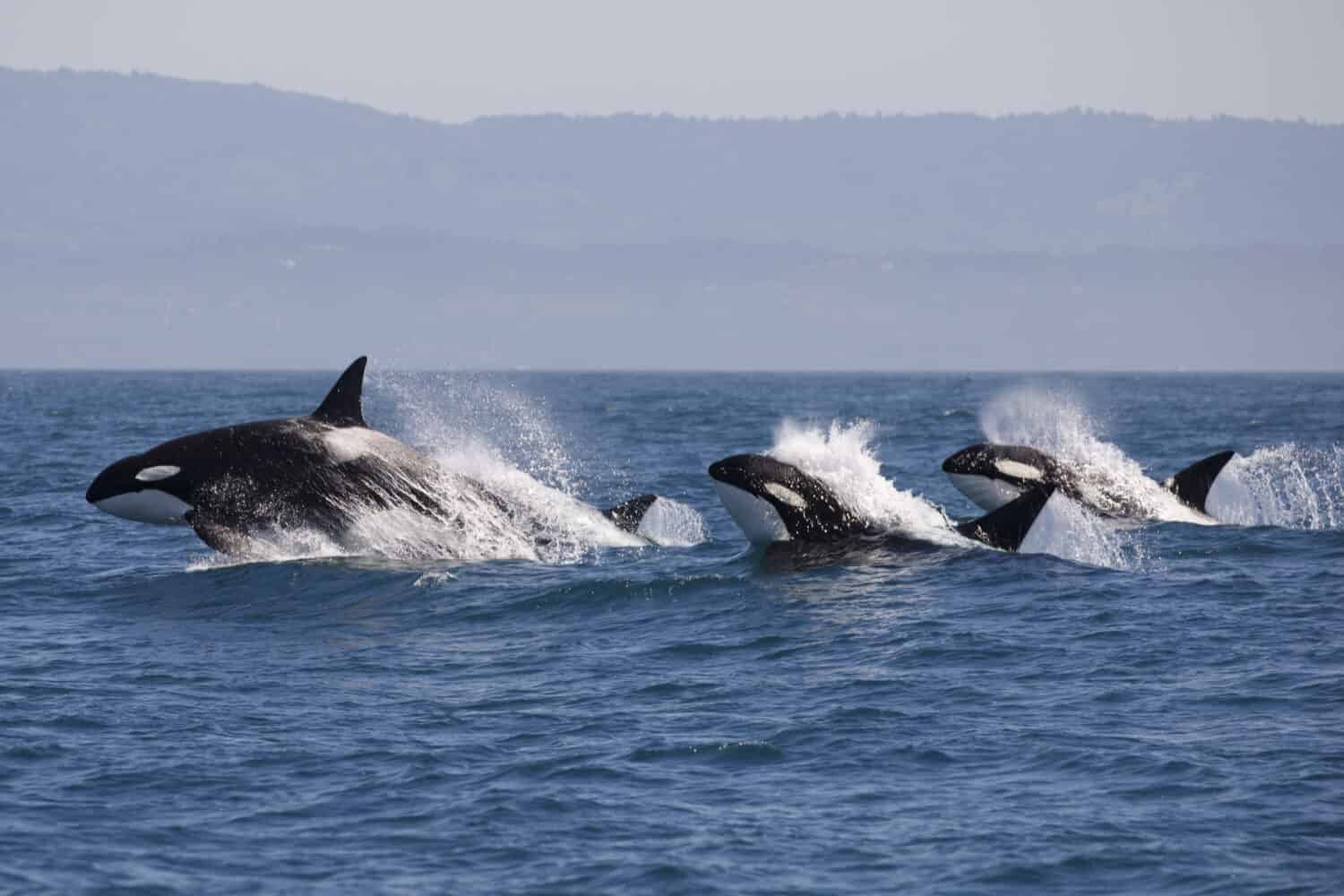
Orcas are categorized into three ecotypes, which include resident orcas, transient orcas, and offshore orcas.
©Tory Kallman/Shutterstock.com
How Far Do Orcas Swim Every Year?
Annual Migration and Habitat
Orcas are widely distributed throughout the world’s oceans, inhabiting cold and warm waters. They exhibit complex migratory patterns, with some populations undertaking extensive journeys spanning thousands of miles each year. These migrations are often influenced by the availability of prey, the geographical location, and the specific population of orcas.
Different populations of orcas exhibit varying migratory behaviors. Some remain resident in a particular region, while others are considered transient or nomadic.
Resident orcas are known to travel shorter distances and tend to occupy specific coastal areas or regions with abundant food sources. These populations have developed distinct dialects and exhibit strong social bonds within their pods.
Transient orcas, on the other hand, have a more wide-ranging lifestyle. They roam across larger expanses of the ocean. These transient orcas are renowned for their hunting strategies and ability to work together as a coordinated team to capture their prey.
Migration Varies Across Ecotypes
Aside from resident and transient populations, offshore orcas spend their time in deeper waters away from the coast. These offshore orcas have been studied less compared to the other ecotypes.
It is important to note that the distance covered by orcas annually can vary widely depending on the specific population and individual behavior. Resident populations tend to have more localized movements, staying within certain coastal regions and covering relatively shorter distances. Transient or offshore populations, on the other hand, exhibit a more nomadic lifestyle and are known to travel greater distances in search of prey.
The ability of orcas to swim such vast distances is a testament to their adaptability and physical prowess. With their streamlined bodies and powerful tails, they are capable of sustained and efficient swimming, allowing them to navigate vast stretches of open ocean and conquer the challenges posed by long-distance migrations.
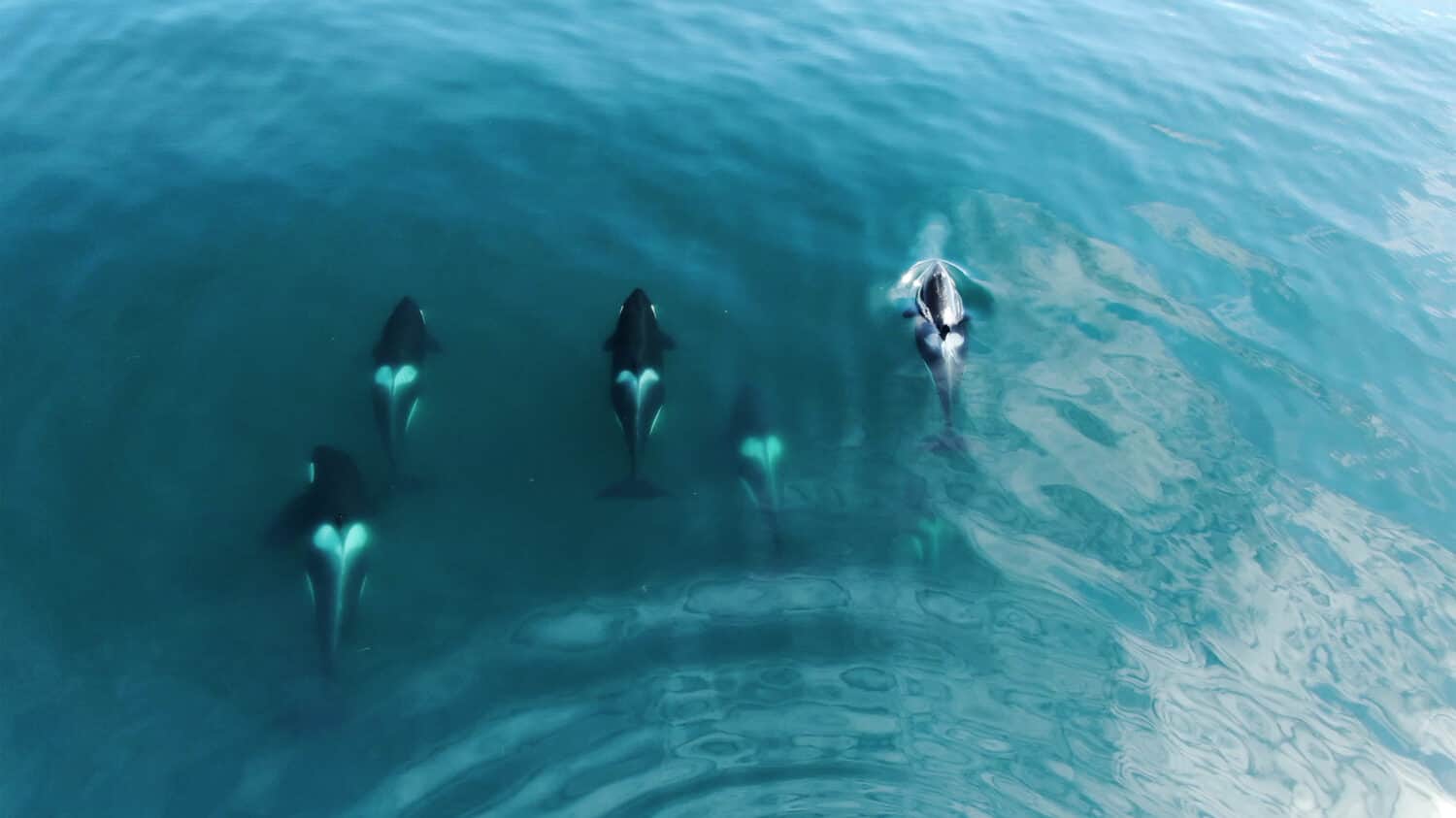
Orcas can swim hundreds and even thousands of miles each year.
©Willyam Bradberry/Shutterstock.com
Characteristics of Orcas
Size and Shape
The orca whale boasts a distinctive appearance with a sleek, streamlined body. These creatures exhibit sexual dimorphism, with males typically growing larger than females. In general, weight and length can vary between the ecotypes of orcas.
Adult males can reach lengths of up to 32 feet and weigh, on average, 6 tons or 12,000 pounds. However, though males can reach considerable lengths, they grow on average from 20 to 26 feet. Conversely, females tend to measure up to 26 feet in length and weigh about 3.5 tons or 7,000 pounds on average. Females more often measure between 16 to 23 feet. At birth, calves weigh as much as 400 pounds and measure roughly up to 8 feet in length.
Coloration and Markings
Orcas have a distinct black-and-white coloration. The upper surface, including the back and dorsal fin, is predominantly black, while the undersides and sides are white. These markings help to camouflage them when viewed from above or below, making it easier to blend in with their surroundings. The exact patterning can vary slightly between males and females, particularly around their genital areas.
Dorsal Fin
One of the most captivating features of orcas is their enormous dorsal fin, which can tower up to 6 feet in height in males, and roughly 3 feet high in females. Primarily males display this characteristic prominent fin, while females possess smaller and even more curved dorsals. These dorsal fins are unique to each individual and can assist researchers in identifying and studying different orca populations.
Pectoral Fins
Orcas have large, paddle-shaped pectoral fins on either side of their bodies. These fins provide stability and control during swimming, allowing them to make precise movements and maneuver through the water with agility. The pectoral fins also play a role in social interactions and communication within pods.
Tail Flukes
The tail flukes of orcas are their primary means of propulsion. The tail flukes are powerful and can generate significant thrust, propelling the orca through the water at impressive speeds. The shape and movement of the tail flukes are distinctive for each individual orca, and people use them for identification purposes.
Teeth
Orcas have a set of large, conical teeth highly adapted for hunting and capturing prey. Depending on the individual and ecotype, they typically have between 40 and 56 teeth. The teeth of an orca can measure up to 3 to 4 inches in length. These marine mammals use them for grasping and tearing apart their prey.
Blowhole
Like all cetaceans, orcas have a blowhole located on the top of their heads. The blowhole allows them to breathe at the water’s surface, expelling spent air and taking in fresh oxygen. The position of the blowhole is visible as a single, vertical slit when they surface to breathe.
Echolocation
Orcas have a highly developed echolocation system, allowing them to navigate and locate prey in their environment. They emit clicks and listen for the echoes, enabling them to build a detailed auditory image of their surroundings. Echolocation also helps orcas communicate with other members of their pod.
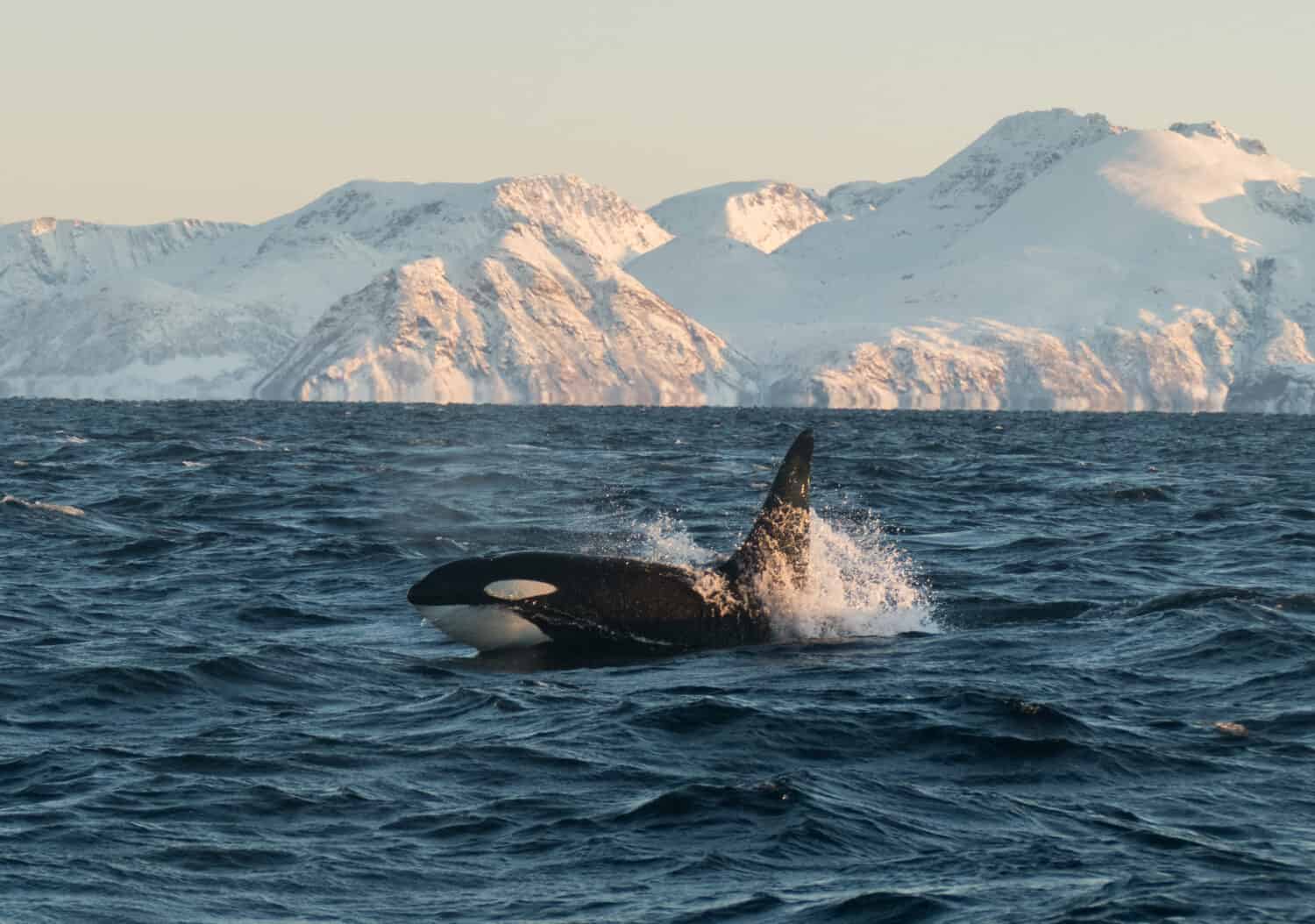
Ocras inhabit both warm and cold oceanic waters worldwide.
©Miguel Schmitter/Shutterstock.com
Other Fascinating Facts About Orcas
Orcas Are Apex Predators
Orcas occupy the top position in the marine food chain, earning their reputation as apex predators. They possess a diverse diet, feeding on a variety of prey, including fish, squid, marine mammals, and even other whales.
Orcas Have Intelligent Social Structures
Orcas exhibit complex social structures and live in tight-knit family groups known as pods. These pods can consist of multiple generations, with offspring staying with their mothers for many years. Within pods, orcas communicate using a distinct vocal repertoire, including clicks, whistles, and calls.
Orca Lifespan and Longevity
Orcas have one of the longest lifespans of any marine mammal. Females can live up to 90 years or more, while males typically have a shorter lifespan of around 50 to 60 years. This long lifespan allows for the development of intricate social relationships within their pods.
Orca Cultural Behavior
Orcas have displayed evidence of cultural behavior, with distinct populations exhibiting unique hunting techniques, vocalizations, and other learned behaviors. These cultural traits are passed down through generations and contribute to the diversity and adaptability of different orca populations.
Orca Conservation Status
Orcas face several conservation challenges, including habitat degradation, pollution, climate change, and interactions with humans, such as entanglement in fishing gear. Some populations, such as the Southern Resident orcas off the coast of North America, are listed as endangered or threatened.
Scientific Study of Orcas is Ongoing
The study of orcas is ongoing, with researchers continually uncovering new insights into their behavior, communication, ecological importance, and even classification. These majestic marine creatures remind us of the wonders beneath the ocean’s surface, inspiring awe and fostering a deep appreciation for the diversity of life in our world’s waters.
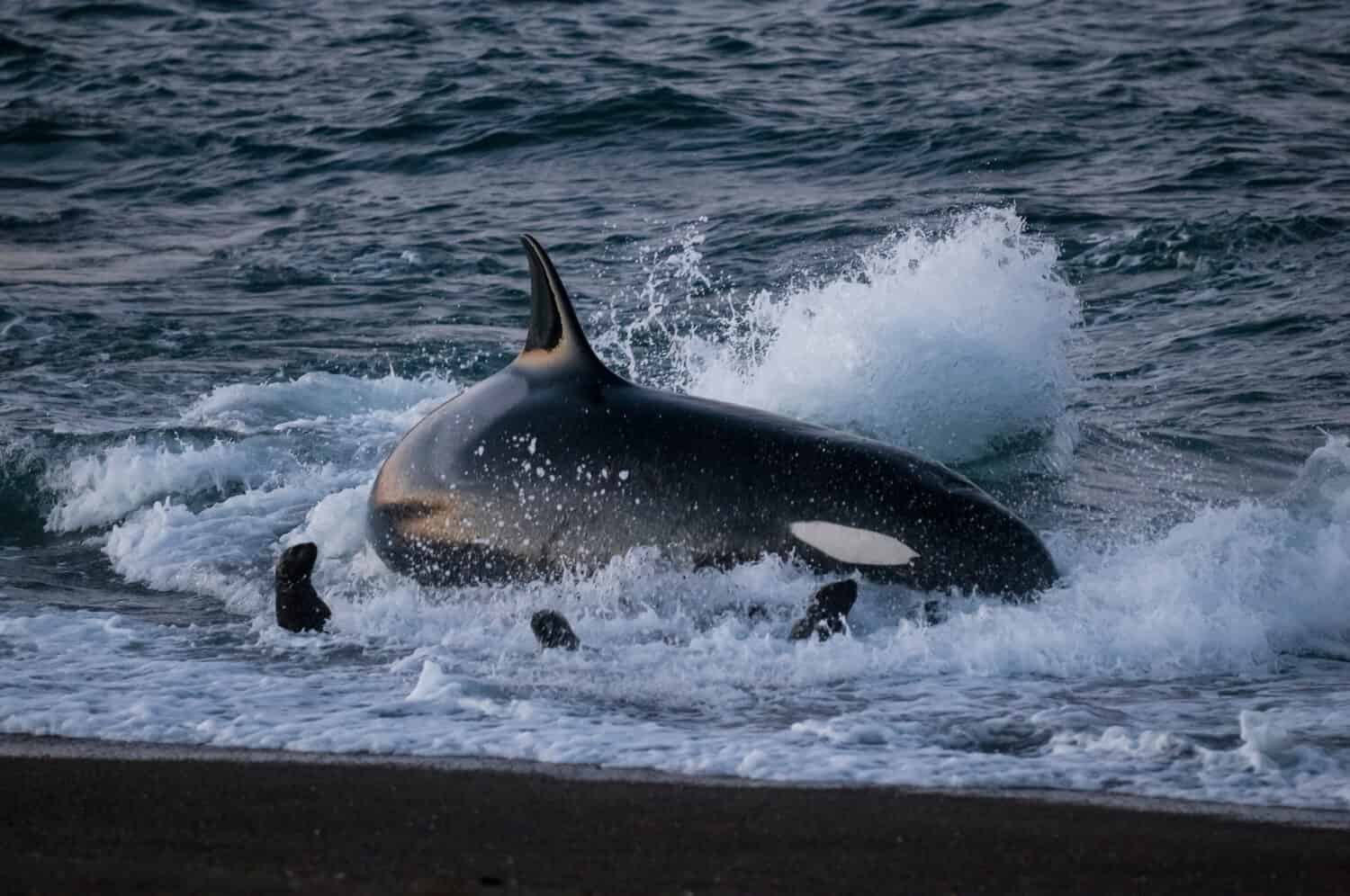
Orcas use top speeds while hunting prey.
©Foto 4440/Shutterstock.com
Conclusion
In conclusion, the orca whale is an impressive creature with exceptional swimming abilities. With their powerful tails and efficient propulsion, orcas can swim at an average speed of 3 to 4 knots (3.5 to 4.6 mph) and reach bursts of speed upwards of 30.4 knots (35 mph) or even more. Orcas’ remarkable swimming speed showcases their agility and adaptability in the marine world, cementing their position as mighty apex predators of the sea.
Thank you for reading! Have some feedback for us? Contact the AZ Animals editorial team.







